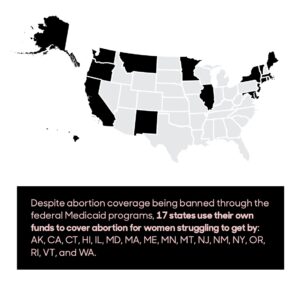The Hyde Amendment is language in the yearly Labor, Health and Human Services, Education and Related Agencies (often shortened to Labor-H or LHHS) appropriations legislation that bars programs in these agencies from covering abortion. This restriction primarily withholds abortion coverage from those qualified and enrolled in the Medicaid health insurance program for low-income people, except in the limited cases of rape, incest, and life endangerment.
The Hyde Amendment is designed to deprive poor and minority women of the constitutional right to choose abortion.”
-Supreme Court Justice Thurgood Marshall (1980)
THE HYDE AMENDMENT PAVED THE WAY FOR OTHER FEDERAL ABORTION COVERAGE RESTRICTIONS
Since the Hyde Amendment passed in 1976, anti-choice politicians have added abortion coverage and funding bans to appropriations language that restricts: Medicaid, Medicare and Children’s Health Insurance Program enrollees; Federal employees and their dependents; Peace Corps volunteers; Native Americans; women in federal prisons and detention centers, including those detained for immigration purposes; women who receive health care from community health centers; survivors of human trafficking; and low-income women in the District of Columbia.
Click here for more on state laws related to insurance coverage of abortion.
REAL WORLD IMPACT OF THE HYDE AMENDMENT
- Medicaid coverage can mean the difference between getting abortion care or being denied. Studies show that when policymakers place severe restrictions on Medicaid coverage of abortion, it forces one in four poor women seeking an abortion to carry an unwanted pregnancy to term.1
- When a woman is living paycheck to paycheck, denying coverage for an abortion can push her deeper into poverty. Indeed, studies show that a woman who seeks an abortion but is denied is more likely to fall into poverty than one who is able to get an abortion.2
- According to the most recent data, 58% of women of reproductive age enrolled in Medicaid or CHIP live in states that ban Medicaid coverage for abortion except in limited circumstances. 51% of these enrollees are women of color.3
- The Hyde Amendment creates an often insurmountable barrier to abortion for women across the country already struggling to get affordable health care, and disproportionately affects those who are low-income, people of color, young, immigrants, or live in rural communities.
The Hyde Amendment is not permanent law. Congress has the opportunity to lift the Hyde Amendment each year. Tell them to take action now.
Sources:
1 Henshaw SK et al., Restrictions on Medicaid Funding for Abortions: A Literature Review, Guttmacher Institute, 2009. Available at http://bit.ly/1IK5XcF.
2 Foster DG, Roberts SCM and Mauldon J, Socioeconomic consequences of abortion compared to unwanted birth, abstract presented at the annual meeting of the American Public Health
Association, San Francisco, Oct. 27–31, 2012. Available at http://bit.ly/1PvNd4w.
3 Donovan, M., In Real life: Federal Restrictions on Abortion Coverage and the Women They Impact, Guttmacher Institute. Guttmacher Policy Review. Vol. 20. 2017. Available. At http://bit.ly/2j6Ec3W.
Downloads
All Above All Hyde Amendment Factsheet
